
© Lachlan Woods . (Click image for larger version)
KAGE
Flesh and Bone
Melbourne, fortyfivedownstairs
8 March 2013
www.kage.com.au
www.fortyfivedownstairs.com
Gender politics is a hot topic in Australia. A video of Prime Minister Julia Gillard publicly scolding opposition leader Tony Abbott for misogyny and sexism across the polished timber table in Parliament recently went viral. Hardly a week goes by without an op-ed on gender discrimination in the country’s papers, as both men and women struggle to come to terms with a society that (whether true or not) appears to value ‘mateship’ and masculine pursuit above everything else.
Apart from responding directly to the wider cultural context of the contemporary gender wars, KAGE’s Flesh and Bone premiered on International Women’s Day. Flesh and Bone, created by Kate Denborough and Gerard Van Dyck, explores the complex, and highly relevant, notion of gender identity and personal connectedness – and particularly how we stereotype the strengths and weaknesses of each gender. To do this, KAGE seems to have bought out a prosthetics shop, with rubbery, disembodied breasts and penises passed back and forth.
The work begins with a man and woman reclining on the floor. In dim light they are barely recognisable- a woman with broad shoulders and a man with long legs. As they begin to undress, we realize that they have swapped genders; Van Dyck and Denborough, sporting matching hairstyles, are heavily padded to change their physiques. He is Denborough, she is Van Dyck; there is a fluidity to both their gender and their individual identities. As the plastic suits finally come off, the dancers are back to ‘normal’ – Denborough wearing the same polka dot dress Van Dyck has removed, and now busy stuffing the fleshy, discarded skins into an oversized black handbag. Any sense of relief at now embodying her ‘proper’ female body is muted as Denborough takes Van Dyck’s proffered hand and follows him offstage.

© Lachlan Woods . (Click image for larger version)
One of the interesting themes in Flesh and Bone is the notion of taking charge. Who is leading this dance? Who is the dominant one? The power is passed back and forth between the two performers, sometimes linked to certain representations of gender, but often as a kind of organic accepting and relinquishing of control.
This fluidity is best demonstrated through a tango that appears time and again, punctuated by partnering work that sees the heavy lifting shared equally. At different points; Denborough is in control, initiating the first dance and matching van Dyck’s dramatic footwork; later she is a dead weight to be tossed from lift to dip. In subtle ways – a leering look or coy gesture – KAGE seems to be mocking our gendered behaviors, arguing, perhaps, that the weaknesses between men and women explored in this work are learned rather than inherent.
Props are an enormous part of Flesh and Bone. It seems that every costume has a hidden pocket, every item has a surprise second use. Apart from the prosthetic genitals and body suits, Flesh and Bone has at least four different backdrops (which are lowered and lifted by the dancers), a pasta machine for an impromptu onstage meal, multiple costumes, a hulu hoop and huge black balls for the dancers to stand on. The strings from a fleet of black balloons succeed in tying the dancers together, almost as though their limbs have been constricted by the expectations of their gender.
Perhaps the most interesting prop is also the smelliest- an industrial size tin of tomatoes that Van Dyck hurls at Denborough from across the stage. The tomato stains Denborough’s white singlet and the white wall behind, leaving chunks of red mess pooling in slippery piles on the floor.
The image of dripping red mush invokes images of menstruation and childbirth– inherent differences between the sexes that no amount of societal construction can fully ignore. But here, as throughout this work, Flesh and Bone remains ultimately polite: intimating something harsher and more relevant, yet backing away from any strong opinion into the relative safety of yet another prop. The tomatoes become a sauce for a pasta dinner; what begins as an aggressive action ultimately devolves into something domestic and shared.
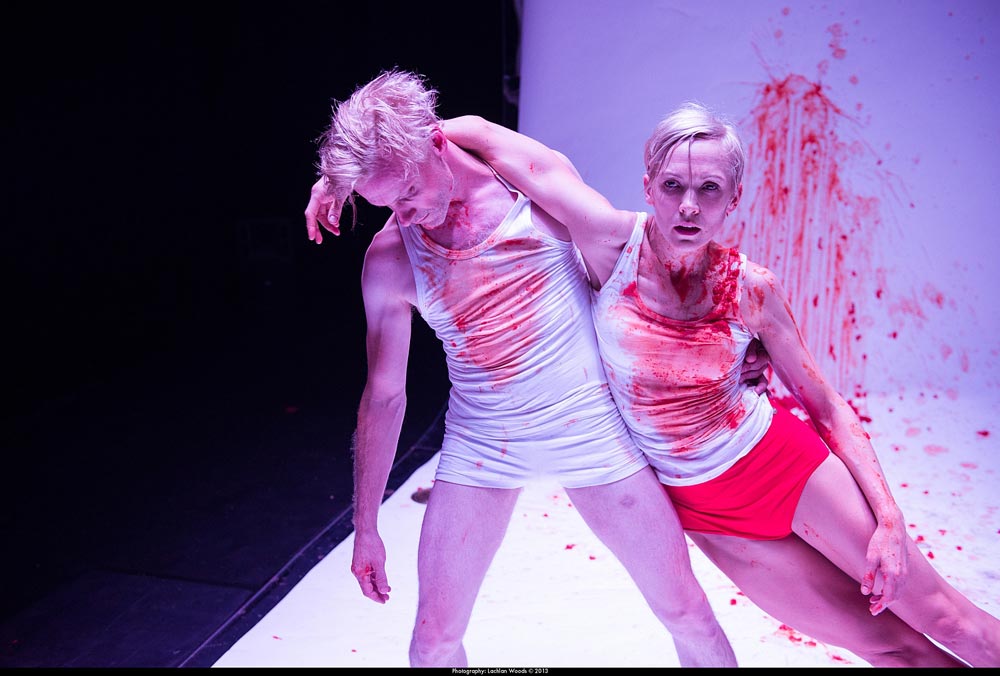
© Lachlan Woods . (Click image for larger version)
Despite the extensive number of props and moving sets, Flesh and Bone remains a careful work – edging up to the topic of gender identity without really stripping it back to the bone. However, it is perhaps the small scale of this work that ultimately makes Flesh and Bone digestible, if not completely satisfying.
Denborough has been the director of KAGE’s recent productions, but her return to the stage as a performer is also a return to the kind of focused partnership that was central to the company’s early works. Denborough is delightful in Flesh and Bone, bringing charisma and nuance to her role, as well as control and beautiful technique. She is, perhaps, the stronger performer of the two, but there is a comfort and familiarity between Van Dyck and Denborough, borne of fifteen years of creative collaboration, that cannot be denied.
The nice thing about a KAGE work is that it really tries to engage with its topic. In an environment where abstraction is often the name of the game for contemporary dance, KAGE is consciously bucking that trend, maintaining their dedication to producing physical theatre work that relies heavily on trained dancers.
At the end of Flesh and Bone, Denborough and Van Dyck recline upon a field of grass, eating fruit (a banana for him, an apple for her). Balloons, now in vivid primary colours, create bright spots of colour against the green backdrop. It is an idyllic Garden of Eden moment that seems to signal a kind of peace- a calling off of hostilities. As much as we may see in this work a larger struggle through the minefield that is gender identity, perhaps Flesh and Bone is merely the story of this man and this woman. Kate Denborough and Gerard Van Dyck have maintained a successful collaboration for 15 years, and, prosthetics aside, this work can also be seen as a personal exploration of their professional partnership.







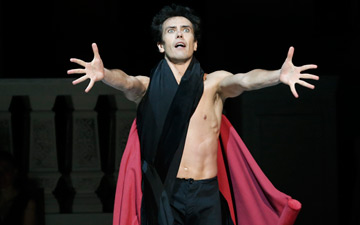




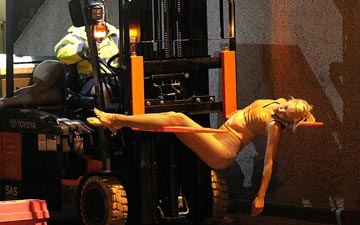
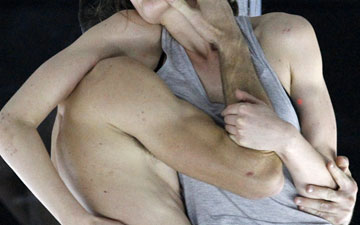

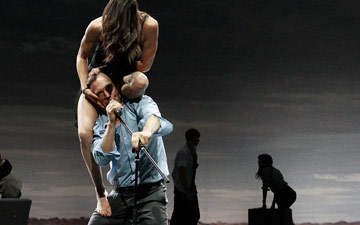

You must be logged in to post a comment.